Pathologic change - Study guides, Class notes & Summaries
Looking for the best study guides, study notes and summaries about Pathologic change? On this page you'll find 2989 study documents about Pathologic change.
Page 3 out of 2.989 results
Sort by
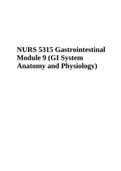
-
NURS 5315 Gastrointestinal Module 9 (GI System Anatomy and Physiology)
- Exam (elaborations) • 26 pages • 2023
-
- $22.49
- 1x sold
- + learn more
NURS 5315 Gastrointestinal Module 9 (GI System Anatomy and Physiology) .Discuss the effects of aging on the gastrointestinal tract. Age related changes in the GI tract begins at age 50 Tooth enamel and dentin wear down→ more vulnerable to cavities Teeth are lost as a result of: o Periodontal (gum) disease o Recession of gums o Osteoporotic bone changes o Brittle roots that fracture easily Taste buds decline in number Sense of smell diminishes Sense of taste de...
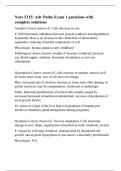
-
Nurs 5315: Adv Patho Exam 1 questions with complete solutions
- Exam (elaborations) • 83 pages • 2024
-
- $16.49
- + learn more
Atrophy Correct Answer-E. Cells decrease in size P. Still functional; imbalance between protein synthesis and degradation. Essentially there is an increase in the catabolism of intracellular organelles, reducing structural components of cell Physiologic: thymus gland in early childhood Pathological: disuse (muscle atrophy d/ decrease workload, pressure, use, blood supply, nutrition, hormonal stimulation, or nervous stimulation) Hyperplasia Correct Answer-E: cells increase in number, mitosi...
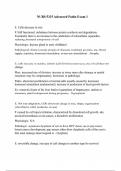
-
NURS 5315 Advanced Patho Exam 1
- Exam (elaborations) • 39 pages • 2024
-
Available in package deal
-
- $12.00
- + learn more
E. Cells decrease in size P. Still functional; imbalance between protein synthesis and degradation. Essentially there is an increase in the catabolism of intracellular organelles, reducing structural components of cell Physiologic: thymus gland in early childhood Pathological: disuse (muscle atrophy d/ decrease workload, pressure, use, blood supply, nutrition, hormonal stimulation, or nervous stimulation) - Atrophy E: cells increase in number, mitosis (cell division) must occur, size of c...
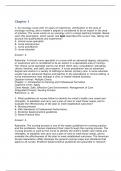
-
Test Bank for Fundamentals of Nursing, The Art and Science of Person-Centered Care, 10th Edition Carol R. Taylor
- Exam (elaborations) • 874 pages • 2023
-
- $29.49
- 1x sold
- + learn more
Test Bank for Fundamentals of Nursing, The Art and Science of Person-Centered Care, 10th Edition 10e Carol R. Taylor, Pamela B Lynn, Jennifer L Bartlett . ISBN 8155 Full Chapters test bank included Unit I Foundations of Thoughtful, Person-Centered Nursing Practice Chapter 1 Introduction to Nursing and Professional Formation HISTORICAL PERSPECTIVES ON NURSING Development of Nursing From Early Civilizations to the 16th Century Florence Nightingale and the Birth of Modern Nursing Devel...
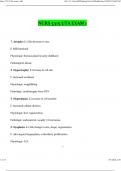
-
NURS 5315: Advanced Pathophysiology 2024 UTA Exam 1 UPDATED VERSION 100% COMPLETE
- Exam (elaborations) • 15 pages • 2024
-
- $14.99
- + learn more
NURS 5315: Advanced Pathophysiology 2024 UTA Exam 1 UPDATED VERSION 100% COMPLETE Atrophy: E. Cells decrease in size P. Still functional Physiologic: thymus gland in early childhood Pathological: disuse 2. Hypertrophy: E. Increase in cell size P. Increased workload Physiologic: weightlifting Pathologic: cardiomegaly from HTN 3. Hyperplasia: E. Increase in cell number P. Increased cellular division Physiologic: liver regeneration Pathologic: endometrial- usually r/t hormones 4. Dyspl...
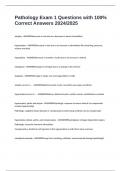
-
Pathology Exam 1 Questions with 100% Correct Answers 2024/2025
- Exam (elaborations) • 14 pages • 2024
-
- $8.99
- + learn more
Pathology Exam 1 Questions with 100% Correct Answers 2024/2025 atrophy - ANSWERSdecrease in size due to a decrease in stress (immobility) hypertrophy - ANSWERSincrease in size due to an increase in stimulation like stretching, pressure, volume overload hyperplasia - ANSWERSincrease in number of cells due to an increase in stimuli metaplasia - ANSWERSchange in cell type due to a change in the stressor dysplasia - ANSWERSchange in shape, size and organization of cells atrophy o...
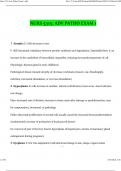
-
NURS 5315 Advanced Pathophysiology Exam 1 2024 Actual Questions with Verified Answers, 100% Guarantee Pass
- Exam (elaborations) • 96 pages • 2024
-
- $12.99
- + learn more
NURS 5315 Advanced Pathophysiology Exam 1 2024 Actual Questions with Verified Answers, 100% Guarantee Pass Atrophy: E. Cells decrease in size P. Still functional; imbalance between protein synthesis and degradation. Essentiallythere is an increase in the catabolism of intracellular organelles, reducing structuralcomponents of cell Physiologic: thymus gland in early childhood Pathological: disuse (muscle atrophy d/ decrease workload, pressure, use, bloodsupply, nutrition, hormonal stimulation, or...
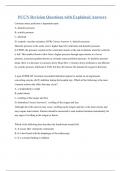
-
PCCN Revision Questions with Explained Answers
- Exam (elaborations) • 43 pages • 2024
-
- $11.49
- 2x sold
- + learn more
Coronary artery perfusion is dependent upon: A. diastolic pressure B. systolic pressure C. afterload D. systemic vascular resistance (SVR) Correct Answers A. diastolic pressure Diastolic pressure in the aortic root is higher than left ventricular end-diastolic pressure (LVEDP), the pressure exerted on the ventricular muscle at the end of diastole when the ventricle is full. This enables blood to flow from a higher pressure through open arteries to a lower pressure, a pressure gradient known...
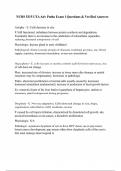
-
NURS 5315 UTA Adv Patho Exam 1 Questions & Verified Answers
- Exam (elaborations) • 67 pages • 2024
-
- $12.00
- + learn more
Atrophy - E. Cells decrease in size P. Still functional; imbalance between protein synthesis and degradation. Essentially there is an increase in the catabolism of intracellular organelles, reducing structural components of cell Physiologic: thymus gland in early childhood Pathological: disuse (muscle atrophy d/ decrease workload, pressure, use, blood supply, nutrition, hormonal stimulation, or nervous stimulation) Hyperplasia - E: cells increase in number, mitosis (cell division) must oc...
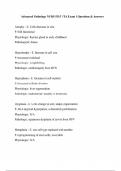
-
Advanced Pathology NURS 5315 UTA Exam 1 Questions & Answers
- Exam (elaborations) • 12 pages • 2024
-
Available in package deal
-
- $13.00
- + learn more
Atrophy - E. Cells decrease in size P. Still functional Physiologic: thymus gland in early childhood Pathological: disuse Hypertrophy - E. Increase in cell size P. Increased workload Physiologic: weightlifting Pathologic: cardiomegaly from HTN Hyperplasia - E. Increase in cell number P. Increased cellular division Physiologic: liver regeneration Pathologic: endometrial- usually r/t hormones Dysplasia - E. Cells change in size, shape, organization P. AKA atypical hyperplasia, a disor...

Do you wonder why so many students wear nice clothes, have money to spare and enjoy tons of free time? Well, they sell on Stuvia! Imagine your study notes being downloaded a dozen times for $15 each. Every. Single. Day. Discover all about earning on Stuvia


